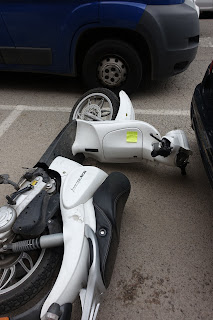Villa Altieri is one of those "Rome the Second Time" places in the middle of Rome rarely visited by the individual, and only occasionally by groups. Last year we encountered it only because we were interested in an exhibit featuring artists' responses to the Resistance in World War II (more about that in a later post). We had no idea of the place to which we were heading. What we found was a magnificently restored building, the kind of restoration for which few can match the Italians, and the layers of Rome that consistently surprise and delight us. At viale Manzoni 47, it's just steps from the Manzoni Metro A stop , on the edge of the Esquilino quartiere.
 |
| Above, the monumental entrance to Villa Altieri. Today one enters on the ground floor, beneath these grand staircases. |
The palazzo is a 17th-century building. Pope Clement X (1670-76) was an Altieri, giving the family money to build this villa on top of an earlier structure.
 |
| The main hall of the ground floor of Villa Altieri has exposed "scavi" - excavations - from the earlier villa and from Roman times. |
A collection of antique statues and other works is well-displayed in the various rooms. It's described as a small museum for the "prestigious" collection of the families that owned the property. Through the glass floor (a little disorienting when one first walks on it) one can see the "ancient" cobbled floors of the prior villa and the "archaeological stratifications" discovered in the restoration work.
 |
| That's me, focused on the art exhibit. You can see the glass floor beneath my feet and some of the statuary in the hall. |

















































